Why Cybersecurity Completes Your Consent Strategy
October 29, 2025
•
4 min read
Table of contents
back
to the top
Why Cybersecurity Completes Your Consent Strategy
Cookie banners and consent management platforms (CMPs) have become standard features of modern websites. They help businesses stay transparent about data collection and build user trust.
But consent alone isn’t enough. To truly protect users and meet compliance standards, you also need to secure the systems that store and process that data. That’s where cybersecurity comes in.
In this blog, we’ll explain how privacy and cybersecurity work together, why both matter, and how combining them builds long-term digital trust.
What Is Data Privacy?
Data privacy defines how personal information is collected, used, and shared, and whether users have meaningful control over it.
It focuses on:
- Consent and transparency
- Purpose limitation
- Data minimization
- User rights (access, correction, deletion)
In essence, privacy ensures that organizations handle data lawfully and ethically — collecting only what’s necessary and with user consent.
Data privacy in practice:
- Websites disclose what data they collect and why
- Users can accept, reject, or customize tracking preferences
- CMPs record and manage this consent transparently
What Is Cybersecurity?
Cybersecurity refers to the technical and procedural safeguards that protect personal and business data from unauthorized access, leaks, or manipulation.
It focuses on:
- Encryption and HTTPS
- Authentication and access control
- Vulnerability scanning and patching
- Threat detection and response
Cybersecurity ensures that data — even after being collected legitimately — remains confidential, intact, and protected.
Cybersecurity in practice:
- Websites use secure cookie settings (
Secure,HttpOnly,SameSite) - Systems are updated regularly to prevent exploitation
- External scans detect weaknesses before attackers can
A Real-World Example
Imagine your business website collects personal data through a contact form — names, emails, maybe phone numbers. You’ve set up a CMP to handle consent properly, allowing users to choose what cookies they accept.
From a privacy standpoint, everything looks perfect.
But under the surface, your server still exposes a few open ports or uses outdated software.
An attacker scanning the internet could find that open entry point, exploit a known vulnerability, and gain unauthorized access to your system. Within minutes, sensitive client information — data that users willingly shared — could be exposed or leaked online.
This kind of breach doesn’t happen because of missing consent. It happens because of missing security controls.
That’s why privacy and cybersecurity must go hand in hand: privacy governs how data is collected; security ensures it stays protected once collected.
Why Privacy Alone Isn’t Enough
Strong privacy controls mean little if your systems are vulnerable.
A business might respect user choices but still suffer a data leak due to outdated software, open ports, or misconfigured servers.
Similarly, perfect security without privacy can lead to unauthorized tracking or unethical data use.
Both are essential:
- Privacy ensures responsible collection.
- Cybersecurity ensures safe protection after collection.
Together, they form a complete framework for compliance and user trust.
How CMP Users Can Strengthen Cybersecurity
CMPs help manage privacy. To complete the picture:
- Enforce HTTPS across all assets
- Audit subdomains and third-party scripts regularly
- Use automated vulnerability scanning tools to detect risks early. For example a tool like FYND can help with that. They provide a free report on your external vulnerability posture.
This proactive approach extends your CMP’s value — from compliant to secure.
Final Takeaway
Data privacy ensures you collect data ethically.
Cybersecurity ensures you keep that data safe.
Modern trust requires both — one protects user rights, the other protects user data.
When CMP users embrace cybersecurity as part of their consent strategy, they create safer, more transparent digital experiences.
Sources
Explore further

Understanding Cookie Policies: A Comprehensive Guide for Website Owners
A clear cookie policy builds trust and ensures compliance. This guide covers key details, risks, and its difference from a privacy policy.
March 24, 2025
3 min

How to Choose a Certified Google CMP Partner
Choose a certified Google CMP partner with Google certification, privacy law compliance, user-friendly features, and reliable support.
December 15, 2024
2 min

Cookie Scripts 101: The Basics of Managing Website Cookies
Learn how cookie scripts manage consent, detect and block cookies, and keep your site GDPR/ePrivacy-compliant—use CMPs instead of building from scratch.
October 22, 2025
3 min


